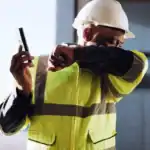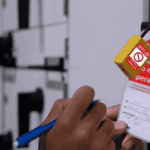
If you operate ladders or stepladders for work, its your legal duty to ensure they are suitable and safe for work and to conduct inspections of them according to the ladder inspection checklist. If an accident occurs due to operation of a faulty ladder, it can result in significant fines. It can also result in serious, life-changing injury.
So, if you oversee those who work on ladders for any part of their work, it’s essential for you to ensure that ladder inspections are conducted regularly and in the right way. This will protect your employees as well as your organisation.
But who can conduct ladder inspections? How often are they needed? And how are they done? In this article, we will take a look at answering these questions to provide you with everything you need to know about ladder inspection.
Why We Need Inspections
The importance of these inspections is directly connected to the high accident occurrence rate when working at height. Falls remain the second leading cause of unintentional injury death worldwide and the number one leading cause in the UK.
From statistics revealed by the Heath and Safety Executive (HSE), falls accounted for more than 30% of all fatal injuries. From the 150 fall-related cased investigated by HSE in a three year duration, 40% of fall from height occurred on ladders.
Ladder Inspection Training
Our Ladder Inspection Training teaches participants how to conduct thorough and effective ladder inspections. It looks at the legal requirements, common faults, inspection procedures and actions to take if a ladder is found unsuitable or unfit for use.
Protect our employees:
In the UK, manual hazards remain one of the biggest causes of workplace injuries. According to the HSE, manual handling is the most common over 7- day injury in the industry. As a result, skilled construction and building trades have one the highest estimated rates of back and upper limb disorders. This amounts to numerous lost working days and a significant financial burden, which is already substantial for the sector.
In 2019/2020, the estimated economic cost of workplace injury and new cases of work-related ill health in construction was £1.2 billion.
Ensure we are compliant with the law
Section 6 of The Work at Height Regulations 2005 requires all employers to assess risks and conduct ladder safety inspections in their respective work environments. These inspections must be conducted at regular intervals by a suitably competent person.
The law also stipulates that inspections must be performed following any event that may have affected the safe use of the ladders. It is crucial for employers to maintain records of all inspections in accordance with the regulations to prevent compliance issues.
In addition, employers and contractors must also refer to the requirements under the Management of Health and Safety at Work Regulations (1999) (MHSWR), and Provision and Use of Work Equipment Regulations 1998 (PUWER 1998).
Who can conduct inspections?
Ladder inspections should only be conducted by a competent person trained in ladder safety. A competent person is someone who has the necessary technical expertise, training and experience in ladder work.
How often should ladders be inspected and records completed?
There is no legally mandated frequency that tells us when we must conduct our ladder inspections. However, the HSE does provide us with recommendations. Pre-use checks should be conducted on ladders every time they are used, while formal visual inspections should be conducted as often as required based on the ladders use and the risk involved.
As a general guideline, ladders used:
- Daily should be inspected every three months
- Weekly should be inspected every six months
- Less than monthly should be given annual inspections
Similarly, it is also important to keep records of all inspections. Any incident that may affect the safety of the ladder such as ladder being accidently dropped must be recorded. These records are a crucial part of your proactive reporting strategy and can be requested by the health and safety officer.
Ladder Inspection Checklist
The ladder inspection process is a continuous cycle that starts from the moment you purchase/rent a ladder. This involves a detailed visual and physical inspection before and after using the ladder. If a ladder you inspected has problems, it must be put out of use. This should include clearly marking the ladder, so that others know that it is unfit for tasks. It should also involve locking the ladder in a secure place.
Here is a ladder inspection checklist that details different parts and components of the ladder that require inspection.
Feet & End Caps
- Feet & top tips fitted, all present,secure, and correct
- Stile ends are undamaged
- All rivets and other fixings are present & secure
- No cracks, cuts, or holes
- Anti-slip surfaces are undamaged
Braces / Cross Tubes
- No excessive bending, bowing, or folding
- All rivets / other fixings are present and secure
- No cracks, cuts or holes in the cross tubes
- No denting that might compromise its strength
- No corrosion that might compromise its strength
- No rotation, wobbling, or twisting
Fixings
- No severe corrosion or wear – screws, bolts, and rivets are tight and in place
- No tell-tale holes where fixings may have been but removed
- No signs of wear or damage
Platforms
- No bending or twisting of upper surface
- No cracks, cuts or holes
- No significant denting that might compromise its strength
- Support bar and other attachments are secure and undamaged
- Linkage mechanism is present and opens/closes with no excessive play
- Anti-slip surface is undamaged and clean from contaminants
Rungs / Treads
- No swaging splits with all rungs present and secure
- No bends, bows or twists – creases, cracks, cuts or holes
- No significant denting that might compromise its strength
- Anti-slip surface is undamaged and clean from contaminants
- All rivets / other fixings are present and secure
Labels
- The labels must be securely attached
- They must be legible to the layman
Stiles / Frame Sections
- No bending, twisting, to stiles and frame section
- Hinging of the front to rear frame attachment is secure
- No creases, cracks, cuts or holes
- No significant denting that might compromise its strength
- No contaminants or dirt on stiles
- No significant corrosion on the components
- All end tips are correctly present and secure
- Stops, bushes, and restraint devices are present and undamaged
- Stabilisers are fitted where required – secure and undamaged
Locking catches
- All fixings are tightly in place. are tight and that there is
- No distortion of the stiles where the locking catches are attached
- No bending, twisting or corrosion present
- Locking catches lock and unlock correctly
Rung Hooks
- Rung hooks are all present and secure
- No displacement or looseness
- No signs of bending, cracks, cuts, or holes
- All rivets / other fixings are present and secure
- No significant corrosion of ferrous components
- The hooks fit easily on the rung
Restraint Devices
- No excessive bending, bowing, or folding
- No excessive force required to open/close restraint devices
- All rivets / other fixings are present and secure
- No cracks, cuts, holes or fraying
Guide Brackets
- Guide brackets are all present and secure.
- No displacement or looseness
- No bending, cracks, cuts or holes
- All rivets / other fixings are present and secure
- No significant corrosion of ferrous components
Human Focus's Ladder Inspection Programme is IIRSM Certified
Although ladders are mainly used for short periods, they can lead to life-ending consequences, if safety is not accounted for. You must have appropriate knowledge and training to feel competent in carrying out the job without endangering yourself or others around you.
Human Focus’s Ladder Inspection Online training programme is specifically designed to teach you how to inspect a ladder. Being IIRSM certified, our programme contains all the necessary awareness, information, and training to inspect and identify ladder problems that can be dangerous to the health and safety of the worker.





















